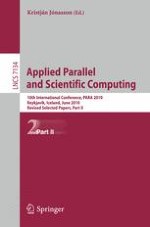The two volume set LNCS 7133 and LNCS 7134 constitutes the thoroughly refereed post-conference proceedings of the 10th International Conference on Applied Parallel and Scientific Computing, PARA 2010, held in Reykjavík, Iceland, in June 2010. These volumes contain three keynote lectures, 29 revised papers and 45 minisymposia presentations arranged on the following topics: cloud computing, HPC algorithms, HPC programming tools, HPC in meteorology, parallel numerical algorithms, parallel computing in physics, scientific computing tools, HPC software engineering, simulations of atomic scale systems, tools and environments for accelerator based computational biomedicine, GPU computing, high performance computing interval methods, real-time access and processing of large data sets, linear algebra algorithms and software for multicore and hybrid architectures in honor of Fred Gustavson on his 75th birthday, memory and multicore issues in scientific computing - theory and praxis, multicore algorithms and implementations for application problems, fast PDE solvers and a posteriori error estimates, and scalable tools for high performance computing.
